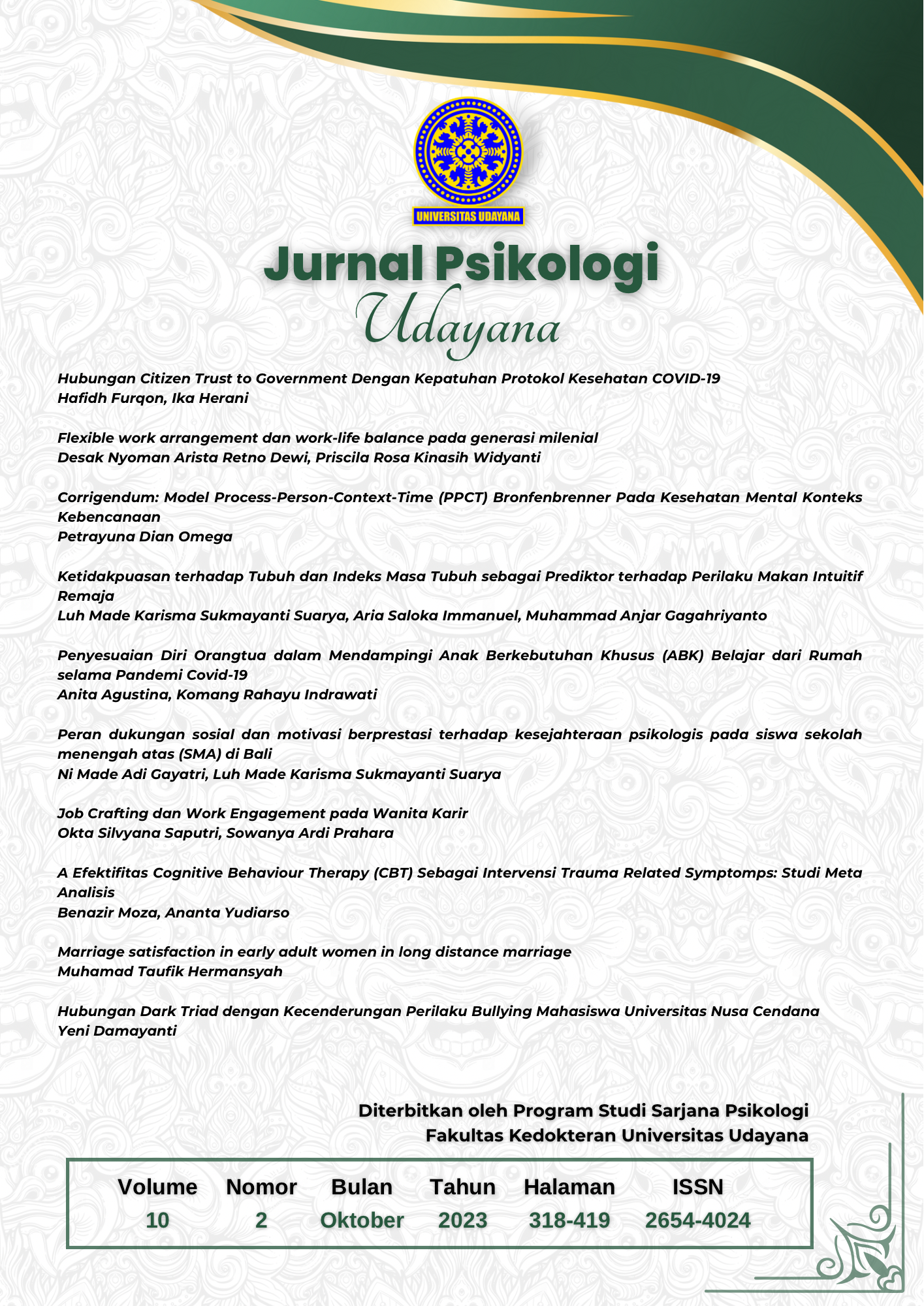Ketidakpuasan terhadap Tubuh dan Indeks Masa Tubuh sebagai Prediktor terhadap Perilaku Makan Intuitif Remaja
Abstract
Abstrak
Idealnya perilaku makan dalam keseharian individu dapat memberikan dampak sehat secara fisik maupun psikososial. Namun, terkadang individu berperilaku makan semata-mata dilakukan karena ketidaknyamanan kondisi psikologis dan sosial, ataupun sebaliknya, perilaku makan yang berdampak pada kondisi fisik dan psikososial yang kurang sehat. Perilaku makan intuitif menjadi salah satu alternatif perilaku makan yang lebih adaptif karena lebih mengandalkan sinyal fisiologis rasa lapar dan rasa kenyang, untuk makan maupun menghentikan aktivitas makan. Agar individu dapat intuitif dalam berperilaku makan dibutuhkan faktor-faktor tertentu. Faktor yang dipertimbangkan dalam perilaku makan remaja adalah ketidakpuasan terhadap tubuh dan indeks massa tubuh. Penelitian ini bertujuan untuk mengetahui peran ketidakpuasan terhadap tubuh dan indeks massa tubuh terhadap perilaku makan intuitif pada remaja. Alat ukur yang digunakan adalah Skala Perilaku Makan Intuitif, Skala Ketidakpuasan terhadap Tubuh, pada remaja sebanyak 135 orang. Reliabilitas Skala Perilaku Makan Intuitif adalah 0,625, dan reliabilitas dimensi kognitif, afektif, serta perilaku pada Skala Ketidakpuasan terhadap Tubuh berkisar antara 0,689-0,835. Hasil uji regresi berganda menunjukkan model prediksi ketidakpuasan terhadap tubuh F(4,130)=5,205, p<0,05, yang mengindikasikan bahwa ketidakpuasan terhadap tubuh dan indeks massa tubuh secara bersama-sama berperan terhadap perilaku makan intuitif, meskipun kemudian ditemukan bahwa hanya dimensi perilaku dari ketidakpuasan terhadap tubuh (beta=-0,391, p<0,05) yang secara signifikan memprediksi perilaku makan intuitif jika dibandingkan dengan prediktor lainnya dalam penelitian ini. Berdasarkan hasil tersebut, patut dipertimbangkan faktor ketidakpuasan terhadap tubuh yang lebih rendah guna membantu perilaku makan remaja yang lebih intuitif sehingga diperolehnya kondisi fisik dan psikososial yang lebih sejahtera.
Kata kunci: indeks massa tubuh, ketidakpuasan terhadap tubuh, perilaku makan intuitif, remaja
Abstract
Ideally, eating behavior should be beneficial for individuals’ physical and psychosocial well-being. However, individuals sometimes exhibit eating behavior that is motivated by psychological and social discomforts, or vice versa, where eating behavior causes unhealthy conditions. In this study, intuitive eating behavior could be one of the alternatives for a more adaptive way of eating because it relies on the physiological cues of hunger and satiety for the individuals to eat or stop eating. There are some known factors for individuals to eat intuitively, such as body dissatisfaction and body mass index. This study aims to investigate the role of body dissatisfaction and body mass index in adolescents’ intuitive eating behavior. There were two instruments employed in this study, namely the Intuitive Eating Behavior Scale and Body Dissatisfaction Scale, which were administered to 135 participants. Reliability for the Intuitive Eating Behavior Scale was 0.625, while the cognitive, affective, and behavioral dimensions of Body Dissatisfaction Scale were ranging from 0.689-0.835. The multiple regression analysis showed a predictive model of body dissatisfaction [F(4,130)=5.205, p<0.05], which indicates that body dissatisfaction and body mass index simultaneously affect intuitive eating behavior, although it was later found that only the behavior dimension of body dissatisfaction (beta=-0,391, p<0,05) that could significantly predict intuitive eating behavior compared to the other predictors in this study. Therefore, it is recommended that the behavioral aspect of body dissatisfaction should be considered as an important factor in adolescents’ intuitive eating behavior in order to achieve a better physical and psychosocial well-being.
Keywords: body mass index, body dissatisfaction, intuitive eating behavior, adolescents
Downloads
References
Al-Musaraf, S., Rogoza, R., Mhanna, M., Soufia, M., Obeid, S., Hallit, S. (2022). Factors of body dissatisfaction among Lebanese adolescents: the indirect effect of self-esteem between mental health and body dissatisfaction. BMC Pediatrics. 22 (302). https://bmcpediatr.biomedcentral.com/articles/10.1186/s12887-022-03373-4
Andrew, R., Tiggerman, M., & Levina, C. (2015). Predictors of intuitive eating in adolescent girls. Journal of Adolescent Health, 56(2), 209-214. http://dx.doi.org/10.1016/j.jadohealth.2014.09.005
Appleton, K., McGowan, L. (2006). The relationship between restrained eating and poor psychological health is moderated by pleasure normally associated with eating. PubMed. 7 (4). DOI:10.1016/j.eatbeh.2005.11.008
Atalay, S., Bas, M., Eren, B., Karaca, E., Bas, D. (2020). Intuitive eating, diet quality, body mass index, and abnormal eating: A cross-sectional study in Turkish women. Journal of Nutrition and Internal Medicine. 22 (4). DOI: https://doi.org/10.23751/pn.v22i4.9773
Augustus-Horvath, C. L., & Tylka, T. L. (2011). The acceptance model of intuitive eating: A comparison of women in emerging adulthood, early adulthood, and middle adulthood. Journal of Counseling Psychology, 58(1), 110–125. https://doi.org/10.1037/a0022129
Babbott, K. M., Cavadino, A., Brenton-Peters, J., Consedine, N. S., & Roberts, M. (2023). Outcomes of intuitive eating interventions: A systematic review and meta-analysis. Eating Disorders, 31(1), 33-63. https://doi.org/10.1080/10640266.2022.2030124
Bernard, J. (2011). Am i really hungry; 6th sense diet intuitive eating. CreateSpace Independent Publishing.
Bruce, L. J., & Ricciardelli, L. A. (2016). A systematic review of the psychosocial correlates of intuitive eating among adult women. Appetite, 96. https://doi.org/10.1016/j.appet.2015.10.012
Cadena-Schlam, L., & López-Guimerà, G. (2014). Intuitive eating: an emerging approach to eating behavior. Nutricion hospitalaria, 31(3), 995–1002. https://doi.org/10.3305/nh.2015.31.3.7980
Cook-Cottone, C. P., Tribole, E., Tylka, T. L. (2013). Healthy eating in school; evidence-based intervention to help kids thrive. DOI: 10.1037/14180-002.
Denny, K. N., Loth, K., Eisenberg, M. E., Neumark-Sztainer, D. Intuitive eating in young adults: Who is doing it, and how is it related to disordered eating behavior? Appetite. 60 (1), 13-19. doi:10.1016/j.appet.2012.09.029
Dion, J., Blackburn, M., Auclair, J., Laberge, L., Veilette, S., Graudeault, M., Vachon, P., Perron, M., Touchette, E. (2015). Development and aetiology of body dissatisfaction in adolescent girls and boys. International Journal of Adolescende and Youth. 20 (2): 151-166. https://doi.org/10.1080/02673843.2014.985320
Dyke, N. V., Drinkwater, E. J. (2013). Relationships between intuitive eating and health indicators. Public Health Nutrition. pg 1-10, https://doi.org/10.1017/S1368980013002139
Eck, K. M., Quick, V., & Byrd-Bredbenner, C. (2022). Body dissatisfaction, eating styles, weight-related behaviors, and health among young women in the United States. Nutrients, 14(18), 3876. https://doi.org/10.3390/nu14183876
Faw, M. H., Davidson, K., Hogan, L., & Thomas, K. (2020). Corumination, diet culture, intuitive eating, and body dissatisfaction among young adult women. Personal Relationships, 1-21. https://doi.org/10.1111/pere.12364
Grogan, S. (2017). Body image: Understanding body dissatisfaction in men, women and children (3rd edition). Routledge.
Goldschmidt, A. B., Aspen V., Hurst, K. T. (2012). Psychosocial correlates of shape and weight concerns in overweight pre-adolescents. NIH Public Access. 41 (1). doi:10.1007/s10964-011-9686-y
Kapoor, A., Upadhyay, M. K., & Saini, N. K. (2022). Relationship of eating behavior and self-esteem with body image perception and other factors among female college students of University of Delhi. Journal of Education and Health Promotion, 11, 80. https://doi.org/10.4103/Fjehp.jehp_855_21
Keirns, N. G., & Hawkins, M. A. W. (2019). The relationship between intuitive eating and body image is moderated by measured body mass index. Eating Behaviors, 33, 91-96. https://doi.org/10.1016/j.eatbeh.2019.04.004
Linardon, L., Tylka, T. L., Fuller-Tyszkiewicz, M. (2021). Intuitive eating and its psychological correlates: A meta analysis. International Journal of Eating Disorders. 54 (6).DOI:10.1002/eat.23509
Maniken, M., Puukko-Viertomies, L-R., Lindberg, N., Siimes, M. A., Aalberg, V. (2012). Body dissatisfaction and body mass in girls and boys transitioning from early to mid-adolescence: additional role of self-esteem and eating habits. BMC Psychiatry. 35. https://bmcpsychiatry.biomedcentral.com/articles/10.1186/1471-244X-12-35
Papalia, D.E., Olds, S. W., Feldman, R.D. (2008). Human development.
Paramitha, N. M. K., Suarya, L. M. K. (2018). Hubungan citra tubuh dan perilaku makan intuitif pada remaja putri di Denpasar. Jurnal Psikologi Udayana. Jurnal Psikologi Udayana.5 (2). 360-369
Rodgers, R. F., Laveway, K., Campos, P., & de Carvalho, P. H. B. (2023). Body image as a global mental health concern. Global Mental Health, 10, e9. https://doi.org/10.1017/gmh.2023.2
Santrock. (2013). Perkembangan masa hidup. Erlangga.
Snoek, H. M., Van Strien, T, Janssens, J. M.A.M, Engels, R. C. M. E. (2008). Restrained eating and BMI: a longitudinal study among adolescents. PubMed. 27 (6). 753-759. DOI:10.1037/0278-6133.27.6.753
Sumartini, E., Ningrum, A. (2022). Gambaran perilaku makan remaja. Jurnal Ilmiah Kesehatan Keris Husada. 6(1): 46-59. https://www.akperkerishusada.ac.id/akperker_ojs/index.php/akperkeris/article/view/65/57
Tylka, T. L., Calogero, R. M., Daníelsdóttir, S. (2019). Intuitive eating is connected to self-reported weight stability in community women and men. Eating Disorders, 1-9. https://doi.org/10.1080/10640266.2019.1580126
Tylka, T. L., & Kroon Van Diest, A. M. (2013). The Intuitive Eating Scale-2: Item refinement and psychometric evaluation with college women and men. Journal of Counseling Psychology, 60(1), 137-153. https://doi.org/10.1037/a0030893
Voelker, D. K., Reel, J. J., & Greenlear, C. (2015). Weight status and body image perceptions in adolescents: Current perspectives. Adolescent Health, Medicine and Therapeutics, 6, 149-158. https://doi.org/10.2147/FAHMT.S68344
Yilmaz, H. O., Arpa, T. E. (2021). The relationship between body mass index and eating disorder risk and intuitive eating among young adults. International Journal of Nutrition Science. 6 (4). 180-188. DOI:10.30476/IJNS.2021.91438.1138

This work is licensed under a Creative Commons Attribution-ShareAlike 4.0 International License.
Authors who publish with this journal agree to the following terms:
- Authors retain copyright and grant the journal right of first publication with the work simultaneously licensed under a Creative Commons Attribution-ShareAlike 4.0 International License that allows others to share the work with an acknowledgement of the works authorship and initial publication in this journal.
- Authors are able to enter into separate, additional contractual arrangements for the non-exclusive distribution of the journals published version of the work (e.g., post it to an institutional repository or publish it in a book), with an acknowledgement of its initial publication in this journal.
- Authors are permitted and encouraged to post their work online (e.g., in institutional repositories or on their website) prior to and during the submission process, as it can lead to productive exchanges, as well as earlier and greater citation of published work (See The Effect of Open Access).













